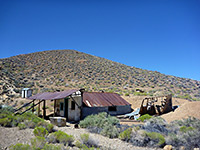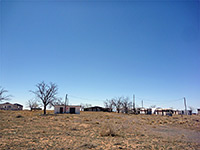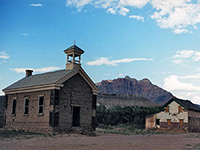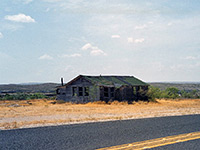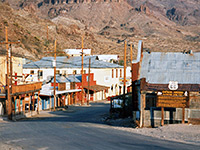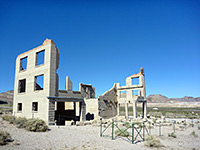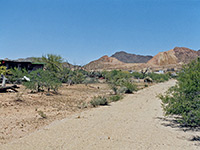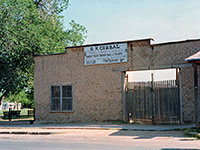Ghost towns of the West are usually associated with mining activity, springing up when the ore was first discovered then quickly abandoned after all was exhausted, so some flourished for just a few years while others managed to survive several decades. A few places classed as ghost towns are still partly inhabited, while many others have largely disappeared, with little or no visible trace at the former townsite; it is rare for a settlement to be completely abandoned but still have a significant number of intact buildings.
Apart from several places managed as commercial enterprises or under state park protection, in general the amount of original relics in a ghost town is proportional to the degree of difficulty in accessing the site, and hence many of the best sites need 4WD vehicles to reach. Also, many lie on private land, where visitors are not permitted. True ghost towns are just one component of the huge number of abandoned structures in the West, others including old mines, old mills and, especially, single dwellings - either isolated buildings out in the countryside or empty houses at the edge of still surviving settlements.
Major centers of mining, and hence locations of ghost towns, include the following:
Arizona - in the central mountains between Phoenix and Flagstaff, in the mountains and valleys of the far southeast, and in the northwest corner, north of Kingman.
California - in the Mojave Desert and to a lesser extent the Sonoran Desert further southeast, in the western foothills of the northern Sierra Nevada, and around the north end of Central Valley, near Redding.
Colorado - scattered locations in the Rocky Mountains in the center and south of the state.
Nevada - various locations across most of the state, except the far north and the far south.
New Mexico - mostly in the mountains of the southwest and west, plus a few around Santa Fe in the north.
Utah - in the southwest, in the east-central regions, and around Salt Lake City in the north.
Texas - isolated places in the far west and along the Rio Grande.
Some sources list over 1,000 Western ghost towns, so the list below is just a tiny sample.
Apart from several places managed as commercial enterprises or under state park protection, in general the amount of original relics in a ghost town is proportional to the degree of difficulty in accessing the site, and hence many of the best sites need 4WD vehicles to reach. Also, many lie on private land, where visitors are not permitted. True ghost towns are just one component of the huge number of abandoned structures in the West, others including old mines, old mills and, especially, single dwellings - either isolated buildings out in the countryside or empty houses at the edge of still surviving settlements.
Major centers of mining, and hence locations of ghost towns, include the following:
Arizona - in the central mountains between Phoenix and Flagstaff, in the mountains and valleys of the far southeast, and in the northwest corner, north of Kingman.
California - in the Mojave Desert and to a lesser extent the Sonoran Desert further southeast, in the western foothills of the northern Sierra Nevada, and around the north end of Central Valley, near Redding.
Colorado - scattered locations in the Rocky Mountains in the center and south of the state.
Nevada - various locations across most of the state, except the far north and the far south.
New Mexico - mostly in the mountains of the southwest and west, plus a few around Santa Fe in the north.
Utah - in the southwest, in the east-central regions, and around Salt Lake City in the north.
Texas - isolated places in the far west and along the Rio Grande.
- Aguereberry Camp, California - small mining camp, now within Death Valley National Park
- Berlin, Nevada - gold-mining town near the Shoshone Mountains, part of Berlin-Ichthyosaur State Historic Park
- Black Rock, Arizona - near the Beaver Dam Mountains and the Utah stateline
- Bodie, California - the best preserved ghost town in the West, located in a particularly isolated part of the state, east of the Sierra Nevada
- Bombay Beach, California - small town beside the Salton Sea, parts of which have been abandoned
- Calico, California - partly restored, commercialized ghost town near Barstow, still containing many original structures and pieces of equipment
- Cisco, Utah - small settlement close to I-70, containing an assortment of abandoned buildings
- Coal Mine Mesa, Arizona - abandoned Navajo trading post, now on the Hopi Reservation
- Copper Creek, Arizona - early 20th century copper mining town, set amongst rocky hills with cacti
- Grafton, Utah - Mormon townsite alongside the Virgin River, near Zion National Park
- Langtry, Texas - isolated, partly inhabited village with a historic past, along US 90 beside the Rio Grande
- Kelso, California - small railway town in the Mojave National Preserve, mostly derelict
- Oatman, Arizona - authentic mining town in the Black Mountains, reached by old Route 66
- Rhyolite, Nevada - evocative settlement with several large ruined buildings, near Beatty
- Silver Bell, Arizona - old mining settlement, now within Ironwood Forest National Monument
- Skidoo, California - townsite west of Death Valley; no houses remain but the adjacent gold mine does have a number of fascinating relics
- Tombstone, Arizona - famous Western settlement, only a partial ghost town, with various historic sites like the O.K. Corral, Bird Cage Theatre and Boothill Graveyard
All Contents © Copyright The American Southwest | Comments and Questions | Contribute | Affiliate Marketing Disclosure | Site Map
